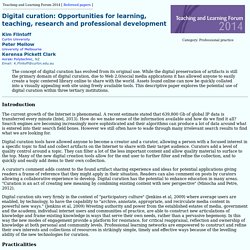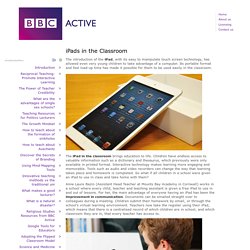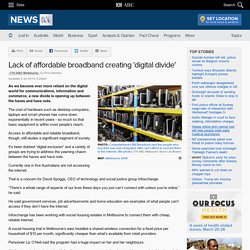

5 Apps to Transform Teaching and Personalize Learning. Transformation requires a journey for teachers toward great educational rewards for students.

Knowing how to craft learning experiences that meld technology with the curriculum is key to crafting digital-age lessons. As digital tools are integrated seamlessly with sound pedagogical practice, a new classroom culture emerges. TL Forum 2014: Flintoff, Mellow and Clark - Digital curation: Opportunities for learning, teaching, research and professional development. Digital curation: Opportunities for learning, teaching, research and professional development Kim FlintoffCurtin UniversityPeter MellowUniversity of MelbourneKerensa Pickett ClarkAoraki Polytechnic, NZ Email: K.Flintoff@curtin.edu.au The concept of digital curation has evolved from its original use.

While the digital preservation of artifacts is still the primary domain of digital curation, due to Web 2.0/social media applications it has allowed anyone to easily create a topic centered library online to share with the world. Why Scoopit Is Becoming An Indispensable Learning Tool. Leanna Johnson, Learning with Technology Scoop.it collates work from online publications using an online magazine format, and this visual impact alone makes it very effective.

The additional appeal of broadcasting from a hub allows me to tap into and share with my ed tech networks, which is why I find myself using it more often during time constraints. Office of the Children's eSafety Commissioner. 1925. What is lifelong learning? The emphasis is on learning to learn and the ability to keep learning for a lifetime.

The European Commission (2001: 9) found that lifelong learning has “Four broad and mutually supporting objectives: personal fulfilment, active citizenship, social inclusion and employability/adaptability”. In this regard, lifelong learning has lifewide dimensions that transcend narrow economic and vocational aspects. The European Lifelong Learning Initiative defines lifelong learning as “…a continuously supportive process which stimulates and empowers individuals to acquire all the knowledge, values, skills and understanding they will require throughout their lifetimes and to apply them with confidence, creativity and enjoyment, in all roles circumstances, and environments.” iPads in the Classroom. The introduction of the iPad, with its easy to manipulate touch screen technology, has allowed even very young children to take advantage of a computer.

Its portable format and fast load-up time has made it possible for them to be used easily in the classroom. The iPad in the classroom brings education to life. 8 Studies Show iPads in the Classroom Improve Education. Since their release in April of 2010, Apple’s iPads have taken the US by storm. iPads have swept through almost every industry, especially education.

Apple is pushing for iPad use in education, and several schools across the US have taken up the charge. The proliferation of iPads in the classroom will only keep accelerating. L523172A EDU App Guide 062013. Content for Year 4 Learning area content descriptions. Getting young people fluent in digital. What do you get when you mix unemployed young people with a blended learning incubator in digital skills?

That's what we at Fluency, a new education technology startup, plan to find out. We hope that our unique method of training young people in the skills that small businesses in the UK need, will be instrumental in helping some of the 1.4 million young people not in education, employment or training in the UK into sustainable employment. Fluency is an education platform helping small businesses succeed online, while at the same time getting unemployed youth into great jobs in the digital economy. The social venture started as a series of pilots funded by UnLtd and the Nominet Trust to train low income women with digital skills that are in demand so that they could become digital freelances.
Lack of affordable broadband creating 'digital divide' Updated As we become ever more reliant on the digital world for communications, information and commerce, a new divide is opening up between the haves and have nots.

The cost of hardware such as desktop computers, laptops and smart phones has come down exponentially in recent years - so much so that basic equipment is within most people’s reach. Nicholas Negroponte: One Laptop per Child, two years on. Lack of affordable broadband creating 'digital divide' The 21st-Century Digital Learner. I give presentations to educators at every level, all around the world.

All of the teachers are earnestly trying to adapt their educational system to the twenty-first century. During my talks, however, I typically look out at oceans of white hair. Never -- I can't even say rarely -- is a kid in sight or invited to the party. It is a measure of the malaise of our educational system that these old folk -- smart and experienced as they may be -- think they can, by themselves and without the input of the people they're trying to teach, design the future of education. A History of Transmedia Entertainment. As embraced by industry professionals and media consumers alike, transmedia storytelling promises to bring greater institutional coordination, added narrative integrality, and deeper engagement to the various pieces of contemporary media franchises.

Comic books, video games, and other markets once considered ancillary now play increasingly significant and recentered roles in the production and consumption of everyday film and television properties such as Heroes, Transformers, and the reenvisioned Star Trek in ways that only very few innovators (such as George Lucas and his carefully elaborated and expanded Star Wars empire) had previously conceived in the twentieth century.
Yet, while contemporary convergence culture has set the stage for a greater embrace of transmedia entertainment, the processes by which stories have been spread across institutions, production cultures, and audiences from different media have a much longer history.